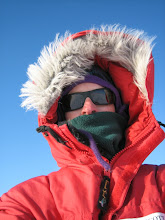There is a large building (named Crary) that houses the various science efforts. I share an office there with others on my project. The building is one of the largest in town, and has about four wings. Lining the halls are displays about the various scientific efforts. There is one display with various fish skeletons, another with sample meteorites found on the Ice, and the halls are lined with posters about projects. The projects range from biological to geological to astrophysical to oceanography. There is even a large aquarium full of Antarctic sea life, and kept at a cool 30F (sea water won’t freeze until about 28F). It includes a touch tank. (The octopus is a fake.) The animals are softer than I expected, and some I have never seen before.
About 30 or 40 years ago a major treaty was signed between the countries with an interest in Antarctica. The Antarctic treaty stated that the continent would only be used for research, and that every caution would be taken to preserve its unique environment. As a result old no longer used bases are being torn down, boxed up, and shipped out. All of our garbage here at McMurdo is transported off-continent. Maybe someone can look up the details of the treaty and let me know.
Some of the cooler projects (in my opinion) are the penguin studies. Anyone who has seen March of the Penguins knows how remarkably adapted these creatures are to this environment. In the water they fly, but in the air they flop. On land they waddle. There are studies to learn about various aspects of their lives: how far do they range when feeding? How dangerous are the waters to them (predators and other natural issues)? Is the presence of humans harming them? Can they recover if we quit harassing them? There is a story of a base that was built on top of a penguin rookery and recently decommissioned. As the parts of the old base were removed (as per the Antarctic Treaty), the penguins began to return and nest again. They may be resilient.
By far the most amazing feature of Antarctica is Lake Vostok. This lake is about 2 miles under ice. It was discovered only recently. What keeps it in liquid form? Pressure? Heat from geothermal sources? Both? Very little is known about it, and most countries want to let it be, thinking that perhaps in millions of years it could become the new cradle of life if something terrible were to happen up here. However, the Russians want to drill down to it to sample it. Some scientists predict that the lake is overpressured, and a drillpipe would result in a gusher reminiscent of the gusher days in oil. The gusher would shoot 1000 ft into the air and last for several weeks before the pressure would be equilibrated. At that point, it is not the same lake. Many countries and environmental groups are opposed to the plan to drill.
I tried to go around and collect some web sites for projects down here, but only was able to get one (http://www.esr.org/antarctic/tides.html). The internet connection from here to the rest of the world is extremely limited, so does not lend itself to web-searching. I encourage you to do google searches for me and put them in a blog comments box. Try that feature out. You might be able to make a comment if you do so anonymously without having to create an account on blogger.com, but if not, you should know that I have not received a single piece of junk mail from blogger.com, so if you sign up I believe it when they say they will keep your information private. I would like to hear from you!
CREAM progress: No flight yet due to low fog over the ice. The winds were light, and the temperature was in the low 40s. Warmer than Cincinnati! Of course, where the wind blew directly off the ice, it was more like 32F. We will try a flight again tomorrow afternoon. Wish us luck.
To pass the time I hiked up Observation Hill, right outside McMurdo. I got a great view of Mt Erebus, and some good exercise. The hike is straight up. A cross on top commemorates the Scott Expedition. Views across the Ross ice shelf were over a lower layer of fog.
Monday, December 12, 2005
Subscribe to:
Post Comments (Atom)

2 comments:
Here's a great site on antarctic research: www.scar.org. Be sure to check out the "Science and Data" section. Among others there is a physical sciences subsection with links to different projects!
Bush is forever saying that democracies do not invade other countries and start wars. Well, he did just that. He invaded Iraq, started a war, and killed people. What do you think? How does that work in a democracy again? How does being more threatening make us more likeable?Isn't the country with
the most weapons the biggest threat to the rest of the world? When one country is the biggest threat to the rest of the world, isn't that likely to be the most hated country?
If ever there was ever a time in our nation's history that called for a change, this is it!
The more people that the government puts in jails, the safer we are told to think we are. The real terrorists are wherever they are, but they aren't living in a country with bars on the windows. We are.
Post a Comment